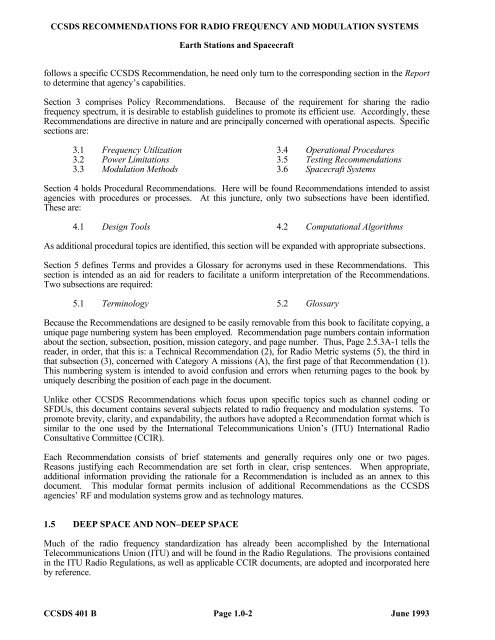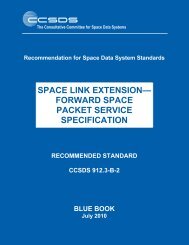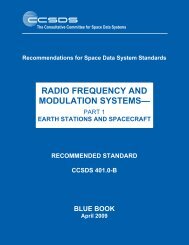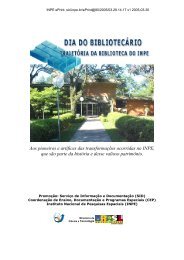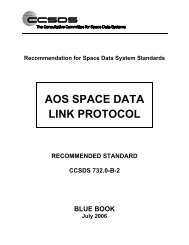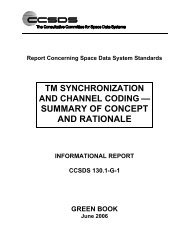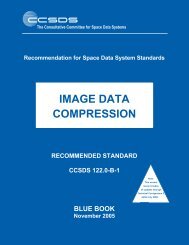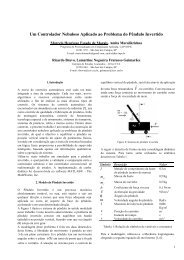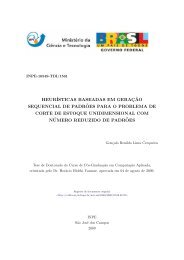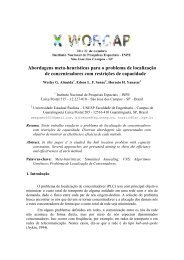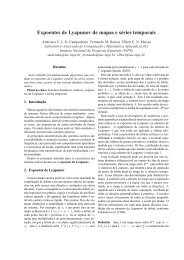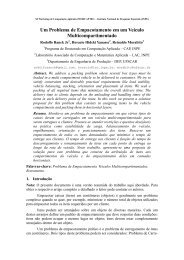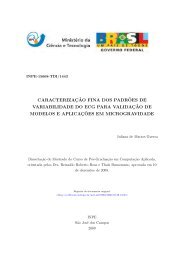CCSDS 401.0-B-21.pdf - mtc-m18:80 - Inpe
CCSDS 401.0-B-21.pdf - mtc-m18:80 - Inpe
CCSDS 401.0-B-21.pdf - mtc-m18:80 - Inpe
You also want an ePaper? Increase the reach of your titles
YUMPU automatically turns print PDFs into web optimized ePapers that Google loves.
<strong>CCSDS</strong> RECOMMENDATIONS FOR RADIO FREQUENCY AND MODULATION SYSTEMSEarth Stations and Spacecraftfollows a specific <strong>CCSDS</strong> Recommendation, he need only turn to the corresponding section in the Reportto determine that agency’s capabilities.Section 3 comprises Policy Recommendations. Because of the requirement for sharing the radiofrequency spectrum, it is desirable to establish guidelines to promote its efficient use. Accordingly, theseRecommendations are directive in nature and are principally concerned with operational aspects. Specificsections are:3.1 Frequency Utilization 3.4 Operational Procedures3.2 Power Limitations 3.5 Testing Recommendations3.3 Modulation Methods 3.6 Spacecraft SystemsSection 4 holds Procedural Recommendations. Here will be found Recommendations intended to assistagencies with procedures or processes. At this juncture, only two subsections have been identified.These are:4.1 Design Tools 4.2 Computational AlgorithmsAs additional procedural topics are identified, this section will be expanded with appropriate subsections.Section 5 defines Terms and provides a Glossary for acronyms used in these Recommendations. Thissection is intended as an aid for readers to facilitate a uniform interpretation of the Recommendations.Two subsections are required:5.1 Terminology 5.2 GlossaryBecause the Recommendations are designed to be easily removable from this book to facilitate copying, aunique page numbering system has been employed. Recommendation page numbers contain informationabout the section, subsection, position, mission category, and page number. Thus, Page 2.5.3A-1 tells thereader, in order, that this is: a Technical Recommendation (2), for Radio Metric systems (5), the third inthat subsection (3), concerned with Category A missions (A), the first page of that Recommendation (1).This numbering system is intended to avoid confusion and errors when returning pages to the book byuniquely describing the position of each page in the document.Unlike other <strong>CCSDS</strong> Recommendations which focus upon specific topics such as channel coding orSFDUs, this document contains several subjects related to radio frequency and modulation systems. Topromote brevity, clarity, and expandability, the authors have adopted a Recommendation format which issimilar to the one used by the International Telecommunications Union’s (ITU) International RadioConsultative Committee (CCIR).Each Recommendation consists of brief statements and generally requires only one or two pages.Reasons justifying each Recommendation are set forth in clear, crisp sentences. When appropriate,additional information providing the rationale for a Recommendation is included as an annex to thisdocument. This modular format permits inclusion of additional Recommendations as the <strong>CCSDS</strong>agencies’ RF and modulation systems grow and as technology matures.1.5 DEEP SPACE AND NON–DEEP SPACEMuch of the radio frequency standardization has already been accomplished by the InternationalTelecommunications Union (ITU) and will be found in the Radio Regulations. The provisions containedin the ITU Radio Regulations, as well as applicable CCIR documents, are adopted and incorporated hereby reference.<strong>CCSDS</strong> 401 B Page 1.0-2 June 1993


